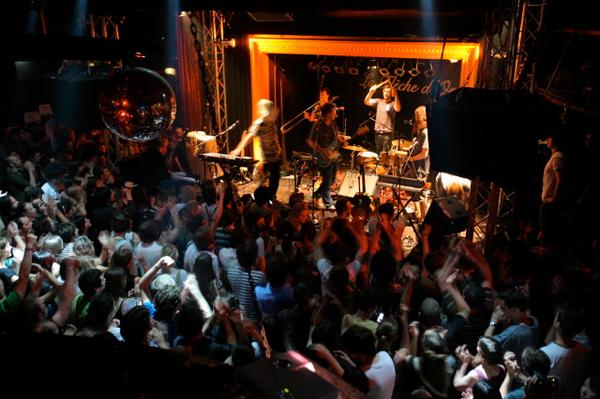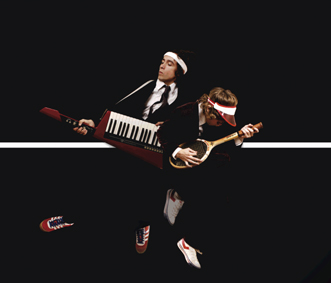By now, our regular readers will be familiar with La Flèche d’Or, our favourite Paris venue and an established stopover for visiting Irish and US indie bands. It hosts three or four quality live acts nearly every night, and continues after midnight with dancing until dawn. Best of all, there’s no admission charge, so it’s a risk-free way of checking out new live music.
 Far from the city centre (but close to the famous Père Lachaise cemetery), the Flèche (right) is in the 20th district of Paris, which is populated mostly by students, artists and working-class immigrant communities. The typical Flèche-goer is either a diehard indie fan or a penniless student; you can see a line of them trudging up the hill from the Alexandre Dumas station every evening, then back down again at midnight for the last metro.
Far from the city centre (but close to the famous Père Lachaise cemetery), the Flèche (right) is in the 20th district of Paris, which is populated mostly by students, artists and working-class immigrant communities. The typical Flèche-goer is either a diehard indie fan or a penniless student; you can see a line of them trudging up the hill from the Alexandre Dumas station every evening, then back down again at midnight for the last metro.
Your blogger hadn’t been to the Flèche since the summer. Anxious to get back into the saddle, we headed up there last Friday to catch a few interesting local bands. But when we drew up outside, we sensed that something was different. Someone had changed the Flèche d’Or.
Sauntering casually in, we were called back by the bouncer. Just as your CLUAS Foreign Correspondent (Paris) was about to throw a diva fit at the door staff, our attention was drawn to some freshly-crayoned signs plastered around: admission is free but you must buy in advance a ticket for your obligatory drink (une concession, in French). But admission is still free, like. It’s just that now you must buy your drinking rights first, or you’re not getting in. But admission is still free. (This semantic debate raged all night, like a punter/bouncer Sorbonne on the steps of the Flèche.)
Now, we’ve no problem buying a drink, even if it’s €6 for a small tumbler of beer (as at the Flèche). And most nights we’d even be willing to pay in. (We had our Dan Deacon experience there and almost felt guilty that it was free. Almost.) What got on everyone’s nerves last Friday night was that this free entry/aggressive concession routine is the hallmark of mean-spirited city centre clubs and tourist traps like the Guinness Tavern. Why is the Flèche d’Or, heretofore agreeably cosy, now acting like a trendy Paris nightspot?
Because it has become a trendy Paris nightspot, that’s why. The crowd was noticeably older, with less teenagers. Minor local celebrities (TV talent show winners, chat show panelists) were swanning around in the way we usually do. And we were surprised to see so many Blackberries being used in an indie rock club.
The Flèche d’Or is profiting from the latest Paris fashion: le look rock. Its genesis is arguably The Libertines’ concert in Paris back in 2003, which inspired the wave of teenage ‘babyrocker’ bands like Plastiscines who appeared on the 2006 ‘Paris Calling’ compilation album. Those bands placed an emphasis on their photogenic skinny-jeans-and-Converse look – and as the music press here refused to take them seriously, their main media outlets proved to be the fashion mags and style supplements. Fashion being so influential in Paris, this attention eventually bled into other media forms: advertising and TV wardrobe departments soon went for the Ramones-esque style too.
So, the bling-bling Riviera dancefloor look is passé and the stylized punk-rock look is in. And to accessorise, the fashion victims of Paris are now looking for the music.
Until now, alternative music has been a minority sport in France, a situation exacerbated by the French indie scene’s inferiority complex in the face of UK and US acts. Air and Daft Punk are not huge household names here. It’s rare that French indie acts even chart in France, let alone break the Top 10. Alternative radio stations like Le Mouv’ and Oui FM, constrained by a 20% language quota in their programming, usually meet their obligations by padding their playlists with new-style chanson française and classic French rock. Top-selling music/culture magazine Les Inrockuptibles gives more space to political comment than local music, which it hides away like a family scandal in an obscure mini-site called CQFD.
 Now that there’s a market for French indie pop, this is changing. French indie acts, growing in self-confidence, are spreading through the radio playlists and earning airplay for their fashionability as much as their quota-friendliness. Young homegrown bands like Housse de Racket (left) and BB Brunes are appearing on primetime TV shows such as ‘Le Grand Journal’ on Canal Plus, which normally invites only established French chart acts or the hippest of visiting Anglophone bands. And the soundtracks to TV ads and reports are more likely to be choppy rhythm guitar than dreamy electro synth.
Now that there’s a market for French indie pop, this is changing. French indie acts, growing in self-confidence, are spreading through the radio playlists and earning airplay for their fashionability as much as their quota-friendliness. Young homegrown bands like Housse de Racket (left) and BB Brunes are appearing on primetime TV shows such as ‘Le Grand Journal’ on Canal Plus, which normally invites only established French chart acts or the hippest of visiting Anglophone bands. And the soundtracks to TV ads and reports are more likely to be choppy rhythm guitar than dreamy electro synth.
That said, there’s one important qualifier; alt-pop fashion has not yet been translated into actual music sales. France's album and singles charts for the week 10-18 October showed no native indie acts in the Top 50. As soon as French bands start profiting, we’ll know that it’s a revolution and not just a whim.
We mentioned Housse de Racket, and Phantom FM listeners in Ireland may have heard Jim Carroll play this on his show recently - their current single 'Oh Yeah':